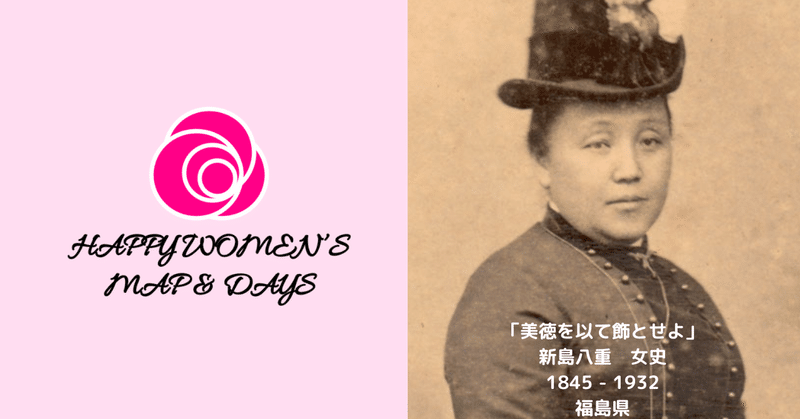
Happy Women's Map 福島県 リーダーシップを発揮した近代女性の先駆者 新島 八重 女史

「美徳を以て飾とせよ」
"Adorn yourself with virtue."
新島八重 女史
Ms. Yae Neesima
1845 - 1932
福島県会津若松市
Born in Aizuwakamatsu-city, Fukushima-ken
新島八重女史は幕末・明治時代に女性砲術師、女性教育者、従軍看護婦、女性茶人として活躍、新しいライフスタイルを実践した近代女性の先駆者です。
Ms.Yae Neeshima is a pioneer of modern women in the late Edo and Meiji periods, actively engaging in various roles such as female artillery officer, female educator, military nurse, and female tea practitioner. She practiced a new lifestyle and made significant contributions.
*******
八重は会津藩の砲術師範に生まれ、裁縫よりも家芸の砲術に興味を示し、特に実兄の覚馬から洋式砲術の操作法を学びます。藩校日新館の教授を務めていた川崎尚之助と結婚。鳥羽・伏見の戦いでの敗北を機に新政府軍から『逆賊』として扱われ、戦火は会津各地そして鶴ヶ城にも広がり籠城戦となります。八重は断髪・男装し、会津若松城に籠城、自らスペンサー銃を持って奮戦します。城内の砲兵隊として最前線の北出丸に銃を据え、土砂を詰めたよろいびつを並べて、肉薄してくる官軍を日々撃退。官軍の攻勢を鈍らせ持久戦に持ち込み、会津藩の陣容を立て直しますが、同盟諸藩とともに会津も降伏。敗戦後、捕虜となった夫と生き別れ、夫の教え子で米沢藩士・内藤新一郎の世話で1年ほどを米沢で過ごします。その後京都府顧問となっていた実兄・山本覚馬からの手紙を頼って上洛。まもなく英語と聖書を学び始めます。兄の推薦により京都に新設された新英学校及女紅場の権舎長・教導試補として働きます。八重は機織りや礼法・習字などを教えながら、京都府知事のもとに学校運営に関して頻繁に交渉に行きます。この頃、兄の元に出入りしていたアメリカン・ボードの準宣教師・新島襄と知り合い結婚。新しい西洋文化を実践しながら、キリスト教主義の学校建設(後の同志社大学)を目指します。ならびに、ドーン宣教師夫人と開いた私塾デイヴィス邸での女子塾、同志社分校女紅場、同志社女学校の創設にも携わります。さらに、大学設立から10年後に京都府看病婦学校と同志社病院を設立してまもなく夫と死別。八重は日本赤十字社の正社員となります。日清戦争が始まった年、日赤京都支部と京都看病婦学校から看護婦40 名を率いて広島第三予備病院に行き4ヶ月間救護活動を行います。看護婦取締役として、怪我人の看護ならびに看護婦の地位向上にも努めます。その後、八重は日赤の補習科で看護を学び、 看護学修業証を得て看護学校の助教師を務めます。日露戦争時には、再び各地の病院を精力的に慰問、大阪陸軍予備病院で2ヶ月間救護活動を行います。 これらの功績によって勲七等宝冠章ならびに勲六等宝冠章が授与されます。八重は女紅場で茶道教授・円能斎の母である伊藤幾久寿と知り合い、茶道に親しむようになります。49歳で茶道裏千家に入門、若い女性たちに茶道を教授し始めます。さらに京都府立第一高等女学校と京都市立第一女学校に八重は「茶義科」を開設。教授に圓能斎と幾久寿を迎えます。それまで男性中心だった茶道は、女子教育の一環として復活します。86歳で逝去するまで女子教育また社会奉仕に活発に活動を続けました。
Yae was born as the artillery instructor of the Aizu domain, showing more interest in the art of artillery than sewing. Particularly, she learned the techniques of Western-style artillery operation from her elder brother Kakuma. She got married to Kawasaki Naosuke, who served as a professor at the domain school Nisshinkan. However, after the defeat in the Battle of Toba-Fushimi, she was treated as a "traitor" by the new government forces, and the war spread to various areas of Aizu, including Tsuruga Castle, leading to a siege. Yae cut her hair and disguised herself as a man, taking part in the defense of Aizuwakamatsu Castle, fighting with a Spencer rifle. She positioned herself with the artillery unit at the forefront of the castle's Kitade Maru, setting up piled-up sandbags to repel the approaching government forces day after day. She delayed the government forces' offensive and managed to regroup the Aizu domain's forces, but ultimately Aizu surrendered along with other allied domains. After the defeat, she became separated from her husband, who had been taken as a prisoner of war, and spent about a year in Yonezawa under the care of Naito Shinichiro, a retainer of the Yonezawa domain. Later, she moved to Kyoto, relying on a letter from her brother Yamamoto Kakuma, who was serving as an advisor to Kyoto Prefecture. She soon began learning English and the Bible. Thanks to her brother's recommendation, she started working as a teacher and instructional assistant at the newly established Shin-Ei Gakuin School and Women's Red School in Kyoto. While teaching weaving, etiquette, calligraphy, and other subjects, she frequently negotiated with the governor of Kyoto Prefecture regarding school operations. During this time, she became acquainted with Shimizu Toru, a quasi-missionary from the American Board, and they married. Together, they aimed to establish a school based on Western culture and Christian principles (later becoming Doshisha University). Additionally, she was involved in the founding of the women's school at the Davis Residence, which was run by Mrs. Dawn, and the women's school of Doshisha's branch. Furthermore, ten years after the university's founding, she established the Kyoto Prefectural Nursing School and Doshisha Hospital but was soon widowed again. Yae became a full-time employee of the Japanese Red Cross Society. When the First Sino-Japanese War began, she led 40 nurses from the Kyoto Red Cross Branch and Kyoto Nursing School to Hiroshima Third Reserve Hospital, where they engaged in relief activities for four months. As the director of nursing, she worked to improve the status of nurses and provide care for the wounded. Later, she studied nursing at the Red Cross's supplementary course and obtained a nursing certificate, becoming an assistant professor at a nursing school. During the Russo-Japanese War, she energetically visited hospitals in various places for relief work and spent two months at the Osaka Army Reserve Hospital. For her contributions, she was awarded the 7th and 6th Order of the Sacred Treasure. Yae became acquainted with Ito Ikukusu, the mother of the tea master Ennosai, through the Women's Red School and developed an interest in tea ceremony. At the age of 49, she joined the Urasenke school of tea ceremony and began teaching tea ceremony to young women. She also established a "Tea Ceremony Department" at the Kyoto Prefectural First High School for Girls and Kyoto Municipal First Girls' School, inviting Ennosai and Ikukusu as instructors. The previously male-dominated tea ceremony was revived as part of female education. She continued to actively engage in women's education and social services until her passing at the age of 86.
-會津藩校 日新館 Aizu-Nisshinkan
-同志社大学 Doshisha University

Share Your Love and Happy Women's Story!
あなたを元気にする女性の逸話をお寄せください!
Share your story of a woman that inspires you!
この記事が気に入ったらサポートをしてみませんか?
